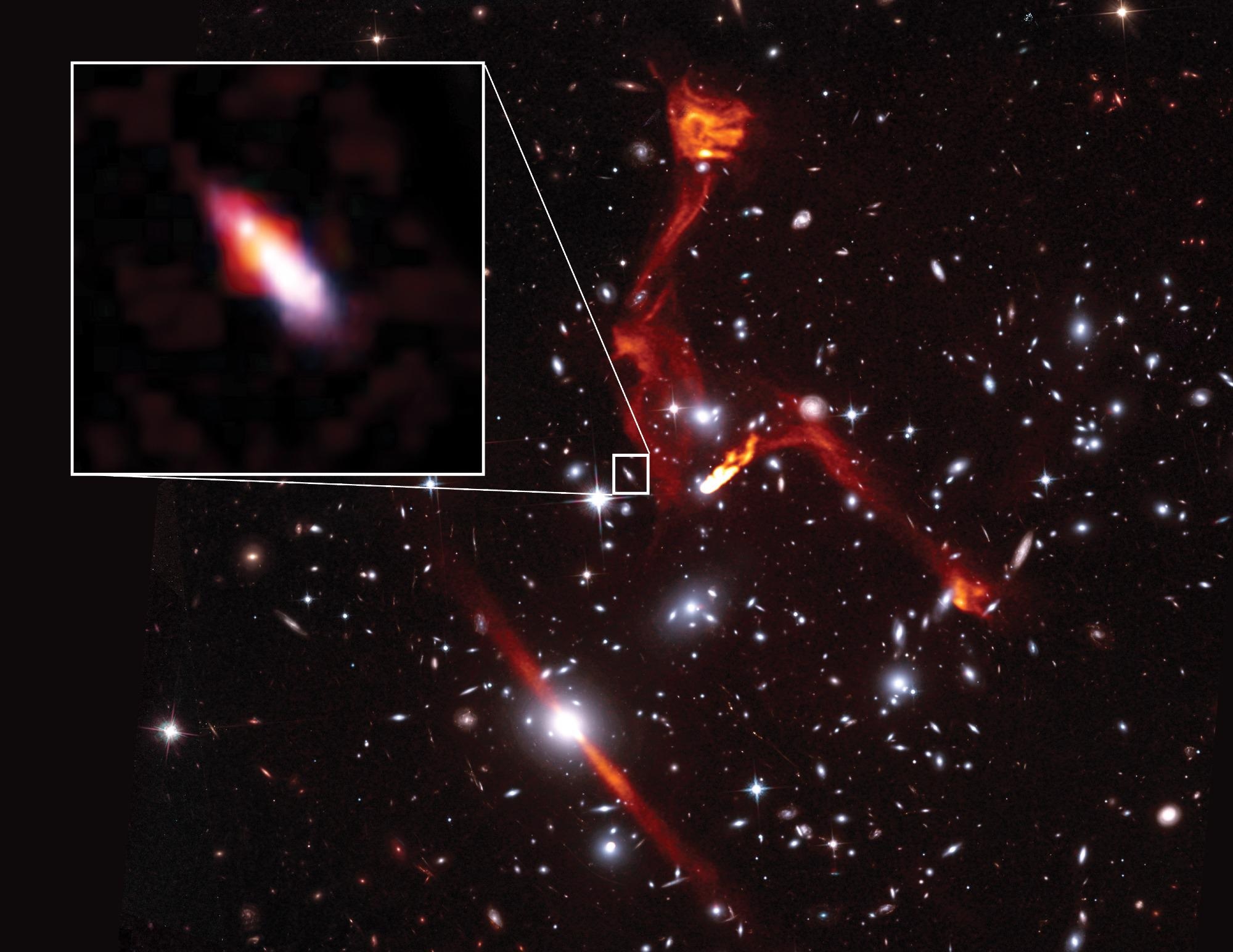Mar 17 2021
Radio telescopes—the most sensitive radio receivers in the world—can detect even extremely feeble wisps of radio emission from objects at the farthest boundaries of the universe.
 VLA radio image superimposed on a Hubble Space Telescope image of the galaxy cluster MACSJ0717.5+3745. Pullout shows distant galaxy VLAHFF-J071736.66+374506.4, far beyond the cluster, and likely the faintest radio-emitting object ever detected. The cluster is more than 5 billion light-years from Earth; the background galaxy more than 8 billion light-years distant. Image Credit: Heywood et al.; Sophia Dagnello, NRAO/AUI/NSF; STScI.
VLA radio image superimposed on a Hubble Space Telescope image of the galaxy cluster MACSJ0717.5+3745. Pullout shows distant galaxy VLAHFF-J071736.66+374506.4, far beyond the cluster, and likely the faintest radio-emitting object ever detected. The cluster is more than 5 billion light-years from Earth; the background galaxy more than 8 billion light-years distant. Image Credit: Heywood et al.; Sophia Dagnello, NRAO/AUI/NSF; STScI.
A group of astronomers recently used the National Science Foundation’s Karl G. Jansky Very Large Array (VLA) to make the most of a helping hand from nature to identify a faraway galaxy that is possibly the faintest radio-emitting object identified so far.
The discovery was achieved as part of the VLA Frontier Fields Legacy Survey, headed by NRAO Astronomer Eric Murphy, which involved the use of faraway galaxy clusters as natural lenses to investigate objects located much farther away.
The clusters acted as gravitational lenses in that they used the gravitational pull of the galaxies within the clusters to distort and magnify radio and light waves emitted from the more faraway objects.
In the composite, a VLA radio image is superimposed on a visible-light image from the Hubble Space Telescope. The striking red-orange objects are radio relics, or large structures potentially caused by shock waves, within the foreground galaxy cluster, known as MACSJ0717.5+3745, located over 5 billion light-years from Earth.
Elaborate VLA observations revealed that several of the galaxies in this image emit radio waves besides visible light. From the VLA data, it was clear that one of the galaxies (illustrated in the pullout image) is located over 8 billion light-years away.
Radio and light waves from this galaxy were bent by the gravitational lensing effect of the intervening cluster.
According to the astronomers, the gravitational lens has magnified the radio image of this faraway galaxy, known as VLAHFF-J071736.66+374506.4, by over six times. It was this magnification that enabled the VLA to spot the galaxy.
“This probably is the faintest radio-emitting object ever detected,” noted Ian Heywood, from Oxford University in the United Kingdom. “This is exactly why we want to use these galaxy clusters as powerful cosmic lenses to learn more about the objects behind them.”
The magnification provided by the gravitational lens, combined with extremely sensitive VLA imaging, gave us an unprecedented look at the structure of a galaxy 300 times less massive than our Milky Way at a time when the universe was less than half its current age. This is giving us valuable insights on star formation in such low-mass galaxies at that time and how they eventually assembled into more massive galaxies.
Eric Jimenez-Andrade, NRAO
The astronomers have described their study in a pair of papers to be published in the Astrophysical Journal.